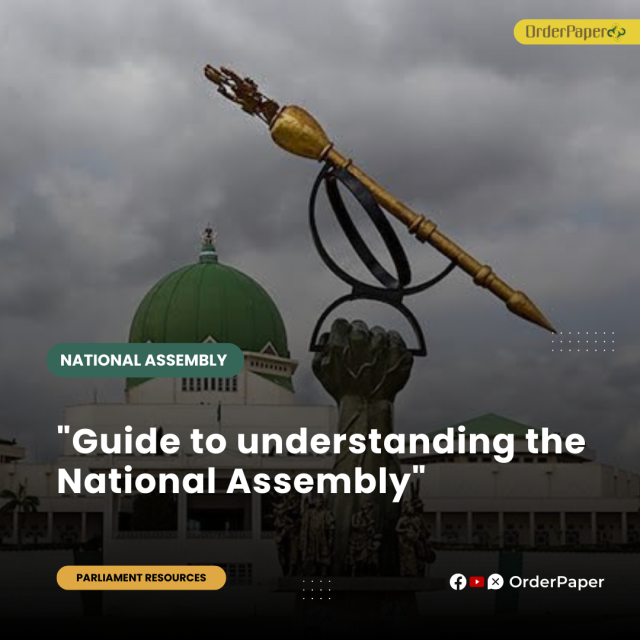Nigeria’s National Assembly is perceived more in a negative light by many in the public domain. But understanding how this all-important arm of government works is vital for anyone interested in governance. This piece provides a simple guide for this purpose

The Nigerian National Assembly is the legislative arm of the federal government and operates as a bicameral legislative assembly.
Located in the Federal Capital Territory (FCT), Abuja, the National Assembly has many legally mandated responsibilities. Among these are representation, oversight, and a plethora of additional functions. The Committees oversee the majority of the National Assembly’s operations. Distinguished Senators and Honourable Members of both Houses are appointed to the Committees based on their professional calling and breadth of life experiences. Legislators also have a crucial say in how public officials and institutions behave in the public interest, especially concerning public expenditure.
Legal Framework of the National Assembly
Section 47 of the 1999 Constitution (as amended) states that “there shall be a National Assembly for the Federation which shall consist of a Senate and a House of Representatives” Section 48 states that “the Senate shall consist of three Senators from each State and One from the Federal Capital Territory, Abuja.” Section 49 states “the House of Representatives shall consist of three hundred and sixty members representing constituencies of nearly equal population as far as possible provided that no constituency shall fall within more than one State.”
About the Senate
The Senate, often referred to as the Red Chamber or Upper Legislative House comprises 109 Senators representing three Senatorial Districts from each of the 36 States of the Federation. In the Chamber, membership is determined by equal representation. Eight Principal Officers and the President and Deputy President of the Senate oversee it.
In addition, the Red Chamber takes action on important national concerns like insecurity, illiteracy, poverty, and epidemics, amongst others. To bring about industrial unity and stabilise the political system of the country, it can also step in and mediate conflicts between the government and labour unions.
Additionally, it has the special authority to impeach the President and Vice President and recommend the removal from office of some senior executive officials, such as the Federal Auditor General, and members of the Independent National Electoral Commission (INEC).
The President’s nominations for Ministers, Ambassadors, Justices of the Supreme Court, Members of statutory Commissions and Agencies, and other positions are required to be confirmed by the Senate.
About the House of Representatives
The House of Representatives is also known as the Green Chamber and is made up of 360 members. Each member represents one federal constituency of Nigeria. The number of constituencies per state varies since population strength is the criteria used to determine the number for each state.
The Green Chamber is led by the Speaker and assisted by the Deputy Speaker along with eight Principal Officers that include Majority Leader, Deputy Majority Leader, Minority Leader, Deputy Minority Leader, Chief Whip, Deputy Chief Whip, Minority Whip and Deputy Minority Whip.
What do Legislators/Lawmakers Do
A legislator or lawmaker has 3 key roles which are the following:
Lawmaking: A legislator or lawmaker holds significant positions in the legislature (Senate and House of Representatives). Just as the name implies, is one who is responsible for making/creating, amending or passing laws. They propose bills, participate in committee hearings to examine and refine legislation and vote on bills.
Representation: As elected by their constituents in their Senatorial Districts or Federal Constituencies, they are expected to represent their interest at all times. They act as a voice for the people who elected them and advocate for their interests, including facilitating projects and employment. This entails being aware of the needs and worries of their constituents, participating in public gatherings and meetings, and interacting with the community to learn about recent events.
Oversight: The actions of the executive arm, such as the implementation of laws, are supervised by legislators. To guarantee accountability and openness in governmental activities, they can organise hearings, call for a probe, and conduct audits of public expenditures.
Leadership structure of the Senate and House of Representatives
- The President of the Senate); and Speaker of the House of Representatives
- Deputy President of the Senate; and Deputy Speaker of the House of Representatives
- Majority Leader (of the Senate and House)
- Deputy Majority Leader (of the Senate and House)
- Minority Leader (of the Senate and House)
- Deputy Minority Leader (of the Senate and House)
- Chief Whip (of the Senate and House)
- Deputy Whip (of the Senate and House)
- Minority Whip (of the Senate and House)
- Deputy Minority Whip (of the Senate and House)
The President of the Senate is the presiding officer whose chief function is to guide and regulate the proceedings in the Senate at plenary. The Speaker of the House of Representatives performs a similar function. The Deputy President of the Senate President carries out the functions of the President in his/her absence, likewise the Deputy Speaker of the House in the absence of the Speaker. Both Deputies also have the role of chairing the Constitution Review Committee of the Senate and House respectively.
The Majority Leader is the Leader of the Senate or House of Representatives. Also known as the Senate Leader or House Leader, he or she is elected by members of the majority party to serve as chief promoter of the party’s interests in Parliament. Bills sponsored by the Executive are presented to plenary by the Majority Leader who has the job of promoting/defending the intendments of the Executive in drafting the proposed law. During plenary sittings, the Majority Leader leads the business of the House or Senate and liaises with various Committee Chairmen. The Deputy Majority Leader is elected to assist the Majority Leader and act in his/her absence.
The Minority Leader who serves as the head of the opposition parties, directs the activities of the minority caucus. Just like the Majority leader, he/she is elected by members of the minority caucus to act as the chief promoter of their interests. The Deputy Minority Leader position is the same as the Deputy Majority Leader.
The Chief Whip, who is always from the Majority party, is elected to ensure discipline, and maintain order and decorum in the chamber. He/she also has the responsibility of managing the affairs of his party during meetings as well as organising the party members in divisions and debates. It is the same responsibility for the Minority Whip who is elected to manage the affairs of the opposition caucus in the the Senate or House. The deputies are elected to assist them and act as the respective Whips in their absence.
The Clerk to the National Assembly (CNA)
The CNA is the Head of the management and bureaucracy of the National Assembly and reports to the President of the Senate or Speaker of the House.
Some of the key roles of the CNA include:
- Coordinating Legislative activities of both Houses.
- Enrolment of Acts of the National Assembly
- Conveying passed laws to the President of the Federal Republic for assent
- Forwarding National Assembly Resolutions to the President via the Secretary to the Government of the Federation
The Clerk of both Chambers
Occasionally, the CNA receives reports from the Clerks of the Senate and the House of Representatives. Both Clerks have two (2) Deputy Clerks each (Legislative and Administration). They oversee the drafting of private member bills and amendments, as well as providing advice and assistance to members, their staff and officers on matters of parliamentary practice and law.
Committees
Committees are temporary or permanent subgroups chaired by designated lawmakers and members who look into certain bills, motions, and other legislative proposals referred to them. They then report their findings to the entire chamber at plenary. Committees are also charged with the responsibility of reviewing and approving government budgets at the level of Ministries, Departments and Agencies (MDAs) of the Federal Government. They also conduct oversight functions on executive agencies under their purview.
The committees are also saddled with the responsibility of investigating alleged breaches of the law and financial misconduct. To promote transparency and accountability, these committees hold public hearings for MDAs, individuals or stakeholder groups to air their views. They are often created in line with the extant responsibilities of government MDAs. There are several types of committees, including:
- Standing Committees
Standing committees are permanent committees that consider bills and issues referred from plenary on which they make recommendations to the general house after a specified time. They aid in the day-to-day activities of the House or Senate.
- Special Committees
These committees, according to the Senate and House standing rules, are created for specific purposes. In some cases, members of Special Committees are to be appointed within the first fourteen days following the first sitting. This is especially true for those who serve as the livewire of the assembly in its early days. An example is the Committee on Selection, which selects and nominates members to the various standing committees.
- Joint Committee
The Joint committee is a combination of two or more similar committees from both chambers or one chamber to solve or look into a specific issue under their purview.
- Ad-Hoc Committee
These are committees created as a matter of urgency for a limited time to address specific issues. As soon as the committee successfully carries out the tasks given to it, the committee is immediately dissolved.
NB: The Committee of the Whole is a committee consisting of every member of the chamber (either Senate or House of Representatives) presided over by its Presiding Officer who will now sit as the chairman of the Committee. During plenary sittings, either of the chambers can resolve into the committee of the whole to consider a bill clause by clause. for it to become law.
Act –A Bill turned into law, i.e. passed by both Houses and assented to by the President.
Adjournment – The closure of business of a sitting or session of the legislative house or its committees.
Amendment Bill – A Bill introduced to change a particular provision or provisions in an already existing Act.
Bill – A proposal for a new law presented or for a proposal for the amendment of an existing law, presented before the legislature.
Caucus – Members of the same party, state, or geo-political zone.
Calling the House to Order: To maintain order and ensure a quiet session, The Chief Whip of the House typically shouts the command “order” during rowdy sessions of the House.
Chamber – This is where the proceedings of the House are conducted.
Clause – An individually numbered provision in, or part of, a Bill. Once a Bill becomes an Act, its clauses are called sections.
Constituency – A geographical area assigned to be represented in parliament by a Senator or House of Representatives Member
Debate – A formal discussion led by parliamentarians in which members of the House are given the chance to voice their opinions on any issue.
Mace – The mace is a representation of the National Assembly’s power. The Serjeant-at-Arms carries it into the Chamber to announce the entrance of the Speaker of the National Assembly or the President of the Senate.
Moving a motion – Moving a proposal by a member that the House do something, order something to be done or express an opinion concerning a particular matter.
Negatived – A bill rejected on the floor of the legislative house.
Order paper – An authorised agenda or programme outlining the matters the legislative house is scheduled to discuss on a given day.
Order of the day – Items of business that the House has directed be scheduled for discussion on a specific day.
Point of Order – A chamber can enforce or follow its own rules or established procedures with the use of a point of order. A Point of Order is raised to demand that rules be enforced when a member notices a rule being broken. Before the irregularity or breach has passed or while the specific question is still pending, a Point of Order must be raised promptly.
Prayers: Every session in both Houses starts with prayers that are not exclusive to any one religion. Before they start sitting, the presiding officer of each chamber is responsible for reading the prayers.
Public Hearing – A parliamentary committee meeting held to hear the public’s or interest groups’ opinions on a topic under consideration.
Out of order – Something that is said or done that is not compliant with accepted parliamentary procedures or norms.
Seconding a motion – Seconding a proposed motion is an indication that there is at least one person besides the mover who is interested in the motion. Seconding a motion does not necessarily signify agreement with the motion. A legislator may second a motion only to secure closure on an issue.
Sergeant-at-Arms – These are officers who ensure order during plenary proceedings and within the precinct of the National Assembly.
Standing Orders or Rules – Each House has created these written Rules to govern its operations. In the Senate, they are referred to as “Rules,” and in the House of Representatives, as “Standing Orders.” They typically exist until the end of a session or legislative assembly.
Recess – a brief temporary suspension of the legislature’s regular operations.
Rule book – A book containing the rules and regulations guiding the behaviours and activities of the lawmakers.
Quorum – This is the requisite number of members, typically in a plenary session, to conduct the day’s business and legally ratify any decisions made there.
Votes and Proceedings – These are minutes of a chamber’s plenary sessions.



